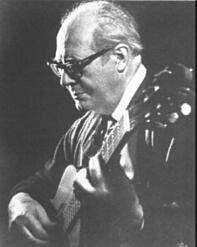| |
 |
Classical guitar page |
 |
| Classics of guitar |
| Andres Segovia (1893-1988) |
 Andalusia. Town Linares. Hose Antonio Street. House, where Segovia was born, isn't kept. At its place is a great building. On the marble plate attached to it we read: "In this house on the 21st of February 1893 was born the guitarist of genius Andres Segovia Torres, outstanding son of the town Linares, 1968". Andalusia. Town Linares. Hose Antonio Street. House, where Segovia was born, isn't kept. At its place is a great building. On the marble plate attached to it we read: "In this house on the 21st of February 1893 was born the guitarist of genius Andres Segovia Torres, outstanding son of the town Linares, 1968".
In some weeks the family went to Haen. Splendid improvisation skill of Andalusia guitarists and the culture of this ancient earth influenced his attitude.
1915 Segovia got acquainted with the guitarist Migel Lyobet, thanks to him, Segovia gave a concert in Barcelona in January 1916. But the guitar was not let in large halls. It wasn't a popular instrument and all thought that strength of its sound was insufficient and it wouldn't be heard in large halls.
The guitar fate was changed by the concert in chamber music palace "Palace" in Barcelona where Segovia was permitted to perform. The beauty of acoustic guitar sounding entranced the audience.
Further successes of Segovia were promoted by the Renaissimento atmosphere, movement for the revival of folk traditions in Spain music and culture. During the next six years the guitarists won recognition of his instrument not only in concert halls of Madrid and Barcelona, but also in other towns of Spain. To this would be added success of two concert tours in South America in 1919 and 1921.
The cardinal problem what Segovia seeked to solve was the creation of original professional repertoire. He got into creative contacts with other musicians and appealed with request to other composers. Manuel de Falia, answering his request, composed a piece "In memory of Debussy". Federico Moreno-Torroba - dances, nocturnes, pieces, preludes, "Castilian Suite", "Castilian Concert". 1919 Segovia made a transcription of Albeniz piano piece "Legend" and it had really a legendary future.
Twentieth years were time of new epoch birth in guitar art and begin of Segovia world recognition. Every performance of Segovia was as a wonder. He aspired to overcome stereotypes and to approve the guitar as a solo instrument.
Andres Segovia and the guitar won Paris, London, and Buenos-Aires. 1928, at the day of his seventh concert in Buenos-Aires, at the same time gave his concert the world-known pianist Artur Rubinstein, at whose performances the halls as by Segovia were overcrowded. But the fears were to no purpose: plates at the halls, where performed Rubinstein and Segovia, told: "no free places".
When in twentieth years the name of the great guitarist was connected with the birth of new art, in thirtieth he would be called the creator of guitar art of the XX century. His noble aim was to elevate the guitar, and a worth place could give only a highly artistic professional repertoire. Segovia didn't search for new compositions, appealed to other composers. His requests answered Moreno-Torroba, Pablo Casals, Hoakin Rodrigo, Federico Mompu, Gaspar Cassado, Manuel Ponce, Villa-Lobos and many other composers of Europe and America. Many of them didn't compose or the guitar before meeting Segovia.
Thanks to Segovia in many conservatories and musical colleges was brought in a guitar class. From 1955 he tought learners in the italian town Siena, then in Santiago-de-Compostella, medieval town in Spain (in Galissia), where for amusement of rich tourists from 1958 were given two weeks festivals, named "Music in Compostella", the principle aim of which was the popularization of spanish ancient and modern music. The festival organizers drew in Segovia, who had here his lessons with learners. The room, where the lessons were carried out - a large hall with stone arches - reminded of a church or abbey. Silence, severe architecture of feudal castle with his internal yards, fragrant roses, walls with twisted vines. In this surroundings every direction of the great musician was perceived with religious trembling and the lessons were retained for the whole life.
|
|
|
|



